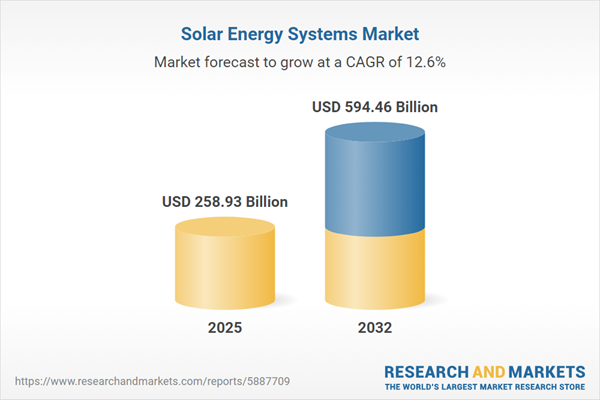Speak directly to the analyst to clarify any post sales queries you may have.
Senior decision-makers in the solar energy systems market operate within a rapidly shifting landscape shaped by regulatory change and technology innovation. Strategic insight, operational agility, and data-driven approaches are essential to navigate competitive dynamics and deliver long-term business value.
Market Snapshot: Solar Energy Systems Market Growth Trajectory
The solar energy systems market is experiencing accelerated global expansion. Market size is projected to increase from USD 229.87 billion in 2024 to USD 258.93 billion in 2025, with a compound annual growth rate of 12.61%. By 2032, the sector is anticipated to exceed USD 594.46 billion, supported by advances in photovoltaic efficiency, the integration of advanced energy storage solutions, and policy initiatives promoting renewables. Organizations in both public and private sectors are responding by refining their capital strategies, targeting market opportunities, and adapting their go-to-market models across economically diverse regions.
Scope & Segmentation: Solar Energy Systems Market
- Product Types: Batteries provide consistent access to stored energy, promoting grid reliability while enabling smoother integration with renewable sources. Charge controllers and inverters are instrumental for energy conversion, regulating power flow and improving operational efficiencies. Solar panels remain the backbone for distributed, commercial, and industrial installations across a range of built environments.
- System Sizes: Large-scale systems address the needs of utilities and enterprises. Medium systems are suited for business campuses and broader infrastructure deployments. Small, customized configurations resolve site-specific or specialized supply chain requirements across diverse use-cases.
- Installation Types: Ground-mounted arrays maximize energy output for utility-scale and expansive commercial projects. Rooftop and building-integrated installations help organizations achieve sustainability targets and leverage existing infrastructure for financial and carbon advantages.
- End-Use Markets: Commercial and industrial sectors value operational reliability and predictable performance. Residential users and utility operators prioritize scalable, flexible systems that seamlessly integrate with energy management frameworks.
- Regional Analysis: Market approaches are tailored to reflect region-specific incentives and grid architectures, with the Americas, Europe, Middle East & Africa, and Asia-Pacific offering unique regulatory frameworks and growth prospects for solar investments.
- Company Coverage: Industry leaders such as LONGi Green Energy Technology, JinkoSolar, JA Solar Technology, and Trina Solar drive innovations across product development and geographic expansion, supporting broad deployment and market adoption.
Key Takeaways for Senior Decision-Makers
- Digital photovoltaic platforms offer real-time system monitoring, supporting responsive operations and optimizing the performance of solar energy assets and grid interfaces.
- Monitoring shifting regulatory environments allows leaders to implement agile procurement plans and mitigate risks related to technology and market transition.
- Integrating advanced energy storage with solar installations ensures uninterrupted service and enables the adoption of flexible service models that reinforce operational efficiency.
- Innovative asset management tools enhance predictive maintenance, extending the functional lifespan and value of infrastructure investments.
- Strong supplier relationships and robust oversight frameworks help safeguard operational continuity and flexibility during changes in policy or supply networks.
- Customizing system architecture to evolving business priorities maintains organizational agility and enhances responsiveness to new market demands.
Tariff Impact: Strategic Responses to 2025 U.S. Trade Policies
Recent updates to U.S. solar tariffs have heightened the need for adaptive procurement strategies and resilient supply chain management. Companies are streamlining sourcing processes, establishing broader supplier networks, and leveraging flexible contracting to stabilize costs and meet phased acquisition needs. Increasing engagement with domestic manufacturers is supporting more reliable project delivery timelines and advancing North American market initiatives.
Methodology & Data Sources
This report synthesizes insights from structured interviews with industry executives, technical reviews, and comprehensive regulatory analysis. Data are drawn both from sector literature and the perspectives of frontline stakeholders, ensuring that findings address current executive objectives and compliance trends.
Why This Report Matters: Solar Energy Systems Market
- Delivers insights for senior leaders on technology developments and policy trends, enabling more informed decisions on market expansion and resource allocation.
- Provides actionable intelligence grounded in industry best practices, supporting procurement and operational targets within evolving market conditions.
- Clarifies segmentation and regional variation, supporting strategic planning for asset deployment and long-term competitive positioning.
Conclusion
A focus on digital transformation, operational flexibility, and robust supply chains empowers leadership teams in the solar energy systems market to secure business value and respond proactively as industry frameworks develop.
Additional Product Information:
- Purchase of this report includes 1 year online access with quarterly updates.
- This report can be updated on request. Please contact our Customer Experience team using the Ask a Question widget on our website.
Table of Contents
3. Executive Summary
4. Market Overview
7. Cumulative Impact of Artificial Intelligence 2025
Companies Mentioned
The companies profiled in this Solar Energy Systems market report include:- LONGi Green Energy Technology Co., Ltd.
- JinkoSolar Holding Co., Ltd.
- JA Solar Technology Co., Ltd.
- Trina Solar Co., Ltd.
- Canadian Solar Inc.
- First Solar, Inc.
- Tongwei Co., Ltd.
- Risen Energy Co., Ltd.
- Hanwha Q CELLS Co., Ltd.
- GCL System Integration Technology Co., Ltd.
Table Information
| Report Attribute | Details |
|---|---|
| No. of Pages | 194 |
| Published | October 2025 |
| Forecast Period | 2025 - 2032 |
| Estimated Market Value ( USD | $ 258.93 Billion |
| Forecasted Market Value ( USD | $ 594.46 Billion |
| Compound Annual Growth Rate | 12.6% |
| Regions Covered | Global |
| No. of Companies Mentioned | 11 |









